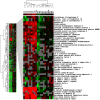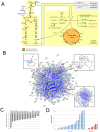Quantitative proteomic analysis reveals potential diagnostic markers and pathways involved in pathogenesis of renal cell carcinoma
- PMID: 24504108
- PMCID: PMC3964225
- DOI: 10.18632/oncotarget.1529
Quantitative proteomic analysis reveals potential diagnostic markers and pathways involved in pathogenesis of renal cell carcinoma
Abstract
There are no serum biomarkers for the accurate diagnosis of clear cell renal cell carcinoma (ccRCC). Diagnosis and decision of nephrectomy rely on imaging which is not always accurate. Non-invasive diagnostic biomarkers are urgently required. In this study, we preformed quantitative proteomics analysis on a total of 199 patients including 30 matched pairs of normal kidney and ccRCC using isobaric tags for relative and absolute quantitation (iTRAQ) labeling and LC-MS/MS analysis to identify differentially expressed proteins. We found 55 proteins significantly dysregulated in ccRCC compared to normal kidney tissue. 54 were previously reported to play a role in carcinogenesis, and 39 are secreted proteins. Dysregulation of alpha-enolase (ENO1), L-lactate dehydrogenase A chain (LDHA), heat shock protein beta-1 (HSPB1/Hsp27), and 10 kDa heat shock protein, mitochondrial (HSPE1) was confirmed in two independent sets of patients by western blot and immunohistochemistry. Pathway analysis, validated by PCR, showed glucose metabolism is altered in ccRCC compared to normal kidney tissue. In addition, we examined the utility of Hsp27 as biomarker in serum and urine. In ccRCC patients, Hsp27 was elevated in the urine and serum and high serum Hsp27 was associated with high grade (Grade 3-4) tumors. These data together identify potential diagnostic biomarkers for ccRCC and shed new light on the molecular mechanisms that are dysregulated and contribute to the pathogenesis of ccRCC. Hsp27 is a promising diagnostic marker for ccRCC although further large-scale studies are required. Also, molecular profiling may help pave the road to the discovery of new therapies.
Figures



References
-
- Lipworth L, Tarone RE, McLaughlin JK. The epidemiology of renal cell carcinoma. J Urol. 2006;176:2353–2358. - PubMed
-
- Weiss RH, Lin PY. Kidney cancer: identification of novel targets for therapy. Kidney Int. 2006;69:224–232. - PubMed
-
- Feldstein MS, Rhodes DJ, Parker AS, Orford RR, Castle EP. The haphazard approach to the early detection of asymptomatic renal cancer: results from a contemporary executive health programme. BJU Int. 2009;104:53–56. - PubMed
-
- Beroukhim R, Brunet JP, Di NA, Mertz KD, Seeley A, Pires MM, Linhart D, Worrell RA, Moch H, Rubin MA, Sellers WR, Meyerson M, Linehan WM, Kaelin WG, Jr, Signoretti S. Patterns of gene expression and copy-number alterations in von-hippel lindau disease-associated and sporadic clear cell carcinoma of the kidney. Cancer Res. 2009;69:4674–4681. - PMC - PubMed
-
- Girgis AH, Iakovlev VV, Beheshti B, Bayani J, Squire JA, Bui A, Mankaruos M, Youssef Y, Khalil B, Khella HW, Pasic MD, Yousef GM. Multi-level whole genome analysis reveals candidate biomarkers in clear cell renal cell carcinoma. Cancer Res. 2012;72:5273–5284. - PubMed
Publication types
MeSH terms
Substances
Grants and funding
LinkOut - more resources
Full Text Sources
Other Literature Sources
Medical
Research Materials
Miscellaneous

